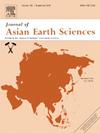Thermo-rheological structure of the lithosphere in Hainan Island, Southeast China and its geothermal significance
IF 2.7
3区 地球科学
Q2 GEOSCIENCES, MULTIDISCIPLINARY
引用次数: 0
Abstract
Based on heat flow, seismic wave velocity, and rheological parameter data, this study constructs a thermo-rheological model of the lithosphere beneath Hainan Island, China. Using this model, we have determined the thermal structure, thermal lithosphere thickness, and rheological structure of the lithosphere beneath Hainan Island. The results indicate a “cold crust, hot mantle” thermal structure, with mantle heat flow ranging from 49 to 58 mW/m2, contributing over 65 % of the total heat flow. Hainan Island exhibits a relatively thin thermal lithosphere that gradually thickens from north to south, and characterized by a high surface heat flow with corresponding changing trends. The rheological structure of Hainan Island follows a “brittle-ductile–brittle-ductile” pattern, characteristic of a “strong crust and weak mantle” configuration. Our analysis suggests that the high thermal state/condition and unique thermo-rheological structure of Hainan Island are closely related to the geodynamic background of Pacific plate subduction and the upwelling of the Hainan mantle plume. This upwelling has led to the formation of a high-temperature anomaly zone in the upper mantle beneath the island. Additionally, the thermal structure of the lithosphere significantly controls its rheological strength, with terrestrial heat flow influencing the regional strength of the lithosphere.

求助全文
约1分钟内获得全文
求助全文
来源期刊

Journal of Asian Earth Sciences
地学-地球科学综合
CiteScore
5.90
自引率
10.00%
发文量
324
审稿时长
71 days
期刊介绍:
Journal of Asian Earth Sciences has an open access mirror journal Journal of Asian Earth Sciences: X, sharing the same aims and scope, editorial team, submission system and rigorous peer review.
The Journal of Asian Earth Sciences is an international interdisciplinary journal devoted to all aspects of research related to the solid Earth Sciences of Asia. The Journal publishes high quality, peer-reviewed scientific papers on the regional geology, tectonics, geochemistry and geophysics of Asia. It will be devoted primarily to research papers but short communications relating to new developments of broad interest, reviews and book reviews will also be included. Papers must have international appeal and should present work of more than local significance.
The scope includes deep processes of the Asian continent and its adjacent oceans; seismology and earthquakes; orogeny, magmatism, metamorphism and volcanism; growth, deformation and destruction of the Asian crust; crust-mantle interaction; evolution of life (early life, biostratigraphy, biogeography and mass-extinction); fluids, fluxes and reservoirs of mineral and energy resources; surface processes (weathering, erosion, transport and deposition of sediments) and resulting geomorphology; and the response of the Earth to global climate change as viewed within the Asian continent and surrounding oceans.
 求助内容:
求助内容: 应助结果提醒方式:
应助结果提醒方式:


